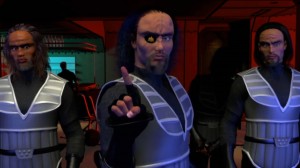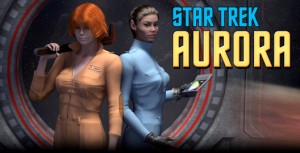 In today’s world of cutting-edge Star Trek fan films, teams of dozens—sometimes hundreds!—work to make these ambitious cinematic endeavors come to life on YouTube, Vimeo, or even a DVD or Blu-ray.
In today’s world of cutting-edge Star Trek fan films, teams of dozens—sometimes hundreds!—work to make these ambitious cinematic endeavors come to life on YouTube, Vimeo, or even a DVD or Blu-ray.
So it’s definitely worth taking notice when a top-tier Trek fan film is produced by only ONE man. Well, I should qualify that. His first episode cast was comprised of 17 people (including the creator himself and his wife Jeannette), the original music was composed by John Catney, and a number of CGI 3D meshes and textures were created by other artists. But everything else – the writing, directing, producing, sets, make-up, wardrobe, lighting, sound, camera angles, editing, and 3D animation – that was all in the hands of one guy: Tim Vining.
And he never even had to get out of his chair!
I’m referring, of course, to Star Trek: Aurora, an original Trek fan film rendered entirely by computer…including all the characters, backgrounds, and VFX (much like Star Wars: Clone Wars or Rebels).
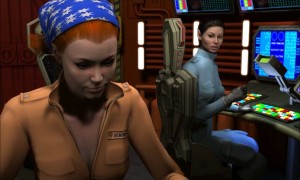
Tim Vining is a life-long Trekker who felt a void in his heart after the cancellation of Star Trek: Enterprise and the loss of weekly-televised Star Trek for the first time in nearly two decades. “Someone should do some kind of Star Trek fan-made film,” Tim thought to himself early in early 2006. If done right, such a project could bring new life to Star Trek, and the fan behind it would be hailed as a hero. Amusingly, Tim would be six months into creating such a project himself before discovering that Trek fan films had already been proliferating on the Internet for more than six years!
Unlike the other fan films out there, though, Tim didn’t have access to the money or resources to construct physical sets or make costumes or do all the things that live-action projects do. But who needs live-action? Tim was an artist and animator, trained in design and illustration. And even though he didn’t work in the movie industry, his day job was managing the illustrators at the New England Journal of Medicine in Massachusetts, and so Tim was quite familiar with the software needed to produce computer animation for a digital movie. And by 2006, CGI software had come down in price and increased in quality enough that a home-based artist with minimal training could compete with the “big guys” (at least to a point).
In fact, Tim had been thinking of developing this kind of a project for a while, and Star Trek seemed the perfect choice for a first attempt. Star Trek typically had a lot of scenes featuring people sitting on the bridge or walking through corridors and talking, which is fairly easy to animate (as opposed to doing some medieval sword and sorcery movie with epic battles and flying dragons). Not that his story would be boring, mind you! Tim knew that even the best CGI animation in the world couldn’t save a poorly-written story.
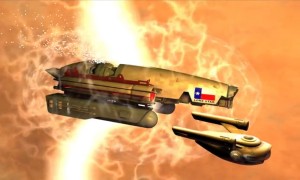
And indeed, it’s the STORY of Star Trek: Aurora that people who see it tend to rave about. It’s Star Trek, but it’s a different kind of Star Trek… the view from the cheap seats, as it were. Y’see, Tim Vining was always most fascinated with the first season episode “Mudd’s Women.” Not one of your favorites? Mine neither. But for Tim, it provided a fascinating look into folks who weren’t serving on a starship. As Tim says on his website:
…it was a rare glimpse into a whole different side of the Trek universe by showing us fleshed-out civilian characters with their own histories and personalities, and suggested endless possibilities for non-Starfleet characters and stories. But for all the civilians – even Harry Mudd – it seemed to me that they’d have to be almost as courageous as the Enterprise crew to leave their home planet behind and put themselves out there in that very same unpredictable and sometimes hostile galaxy – but without a heavily armed starship at their disposal!
So Tim took his inspiration from classic sci-fi authors like C.J.Cherryh who wrote about space merchants, and his two main characters (both strong women, by the way) pilot an old earth cargo ship built a century earlier during the Romulan War. They operate just outside Federation space, without Starfleet to protect them. And as far as they’re concerned, the exploits of Captain Kirk and the USS Enterprise are just something to hear about via subspace chatter or in the bar.
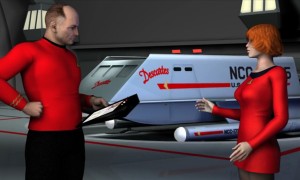
Of course, just watching a human and Vulcan hauling cargo around at warp four for an entire episode would be really boring, and as I said, this story is anything but! In fact, in the first episode, we do get to see a federation starship and crew (but I won’t tell you how – no spoilers! – well, except for me just telling you that we see a Starfleet vessel and crew). But what makes the episode truly rich and engaging are the characters, their backgrounds, and development. This is a story where we see human and Vulcan camaraderie, personal conflict and tension, dark secrets, and emotional intensity. There are scenes that are humorous, others that are suspenseful and even terrifying, and a couple that jerked a tear or two from my eye. I finished the first episode feeling as though I’d just shared an important experience with the main character. It didn’t matter that she was computer-generated; I’d long since stopped even noticing it. The writing and presentation are immersive enough that the viewer is sucked into the story, and that’s the true triumph of Aurora.
I’d also like to comment on the look of the film. For a person with little-to-no professional cinematic experience, Tim Vining produced a visually sumptuous 55-minute episode that is a feast for the eyes. In an early flashback sequence (SPOLIER ALERT – stop now and skip to the next paragraph if you want to watch this completely cold), a foreboding Romulan bird-of-prey passes in front of a nearby sun in silhouette, casting a dark, eerily-green shadow. Combined with the vessel’s silent approach and unknown intentions, this scene will make you shiver.
In a video interview on Trekspeak (still available on Youtube), Tim discusses some of the other little details he was careful of when making this fan film. For example, motion-capture animation sometimes suffers from a phenomenon known as the “uncanny valley.” What this means is that the animated characters look both incredibly realistic but still not realistic enough, and so they can feel a little creepy to some viewers. So one of the “tricks” is to make the characters look a bit less realistic, like using doll-ish eyes rather than photo-realistic eyeballs. Tim also punches up the color saturation, all to make the imagery read as a little more computer generated so as to feel less like it “just missed the mark” of reality.
On the other hand, Tim also goes to great pains to make other aspects as realistic as possible. One great example of this is the blinking and tracking of characters’ eyes. In Aurora, eyes focus on the person speaking and blink at regular intervals. Blinks also happen when characters turn their heads (something most of us do and barely notice). Another amazing example of Tim’s attention to detail comes when a flickering Vulcan candle subtly changes the lighting in a cabin from brighter to dimmer and back again throughout the entire scene.
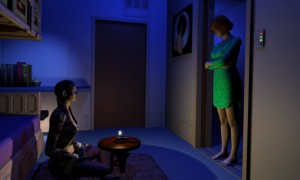
Of course, intricate work like this takes time. Tim initially figured he’d have his pilot episode completed in a year and a half or so. Not even close! Starting work in early 2006, Tim released the last of five parts of his pilot episode in late 2011… nearly six years later! Fortunately for fans, Tim would release each part as he finished it, and so folks could see the story slowly unfold.
And Tim is at it yet again! In September of 2013, he released the first part of his second Aurora episode, “Mudd In Your I.” Nearly a year later, part 2 was released. Early last summer, Aurora fans got their first glimpse of part 3. And just last December, part 4 was added to make the episode 27 minutes long. Only one more part to go and we’ll have two complete episodes!
The second episode is significantly different from the first so far, much more comedic and – strange as it is to say when watching computer-generated characters – kinda sexier. At first, it seemed a little too silly for me to take it seriously. But stick with it because the silly parts become a key piece of a much more serious plot twist, and the episode is a very solid and enjoyable piece of work.
For anyone curious, Tim Vining does all his work on a single Macintosh computer on weekends and late into the night (with a very patient and understanding wife who has a lovely singing voice… you’ll understand what I mean when you watch the episodes). Tim’s musical composer – who approached Tim after seeing the earliest parts of the project – provides an original and immersive score that really helps enrich the entire cinematic experience.
And you’ll be glad you did!
UPDATE (October 17, 2016) – The final part of “Mudd in Your I” was just completed and the series renamed simply to Aurora due to the fan film guidelines forbidding the use of the words “Star Trek” in the title of any fan production.
Also, the guidelines have left the future of Aurora rather uncertain. Tim Vining posted the following to the series website on October 8:
As many fans know, recent guidelines from CBS/Paramount, the owners of Star Trek’s copyright, have placed new restrictions on fan films, in particular regarding the use of recurring original characters in fan films, so the future for Kara and T’Ling is a bit cloudy at the moment. What is not in doubt is our commitment to creating animated stories for people to enjoy and share, so whether that involves Kara and T’Ling, or some new characters or even some “new world,” be watching for further adventures from our little team!
So there you have it. If we never see Kara and T’Ling again, I will be very sad. However, I feel very lucky to have at least gotten to know these two characters over the past few years, and I thank Tim Vining and his team for bringing them to fandom.
Watch the first episode of STAR TREK: AURORA by clicking here.

